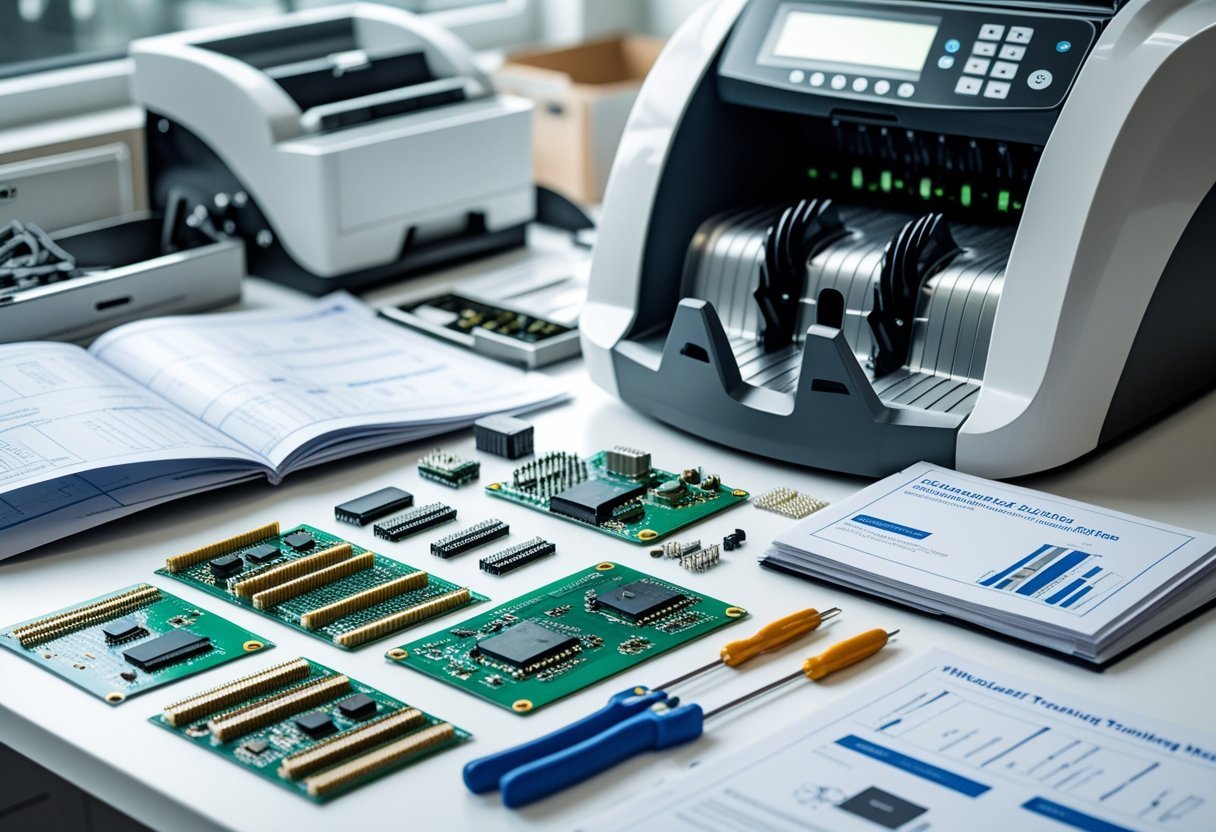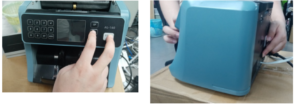지폐계산기는 은행, 소매점, 그리고 매일 많은 양의 현금을 처리하는 기업에 필수적인 장비입니다. 이러한 기계가 고장 나면 운영이 중단될 수 있으므로, 생산성 유지를 위해서는 신속한 수리가 필수적입니다.

도매 수리 키트를 통해 기업은 교체 부품을 즉시 구할 수 있으며, 포괄적인 기술 교육과 서비스 매뉴얼을 통해 직원은 효율적으로 유지관리 및 수리를 수행할 수 있습니다. 현장에 적합한 도구와 지식을 갖추면 가동 중지 시간이 줄어들고 외부 기술자를 기다릴 필요성이 없어집니다. 예비 부품 키트는 생산 라인 가동 시간을 보장합니다. 장비에 고장이 생겼을 때 필수 구성 요소를 제공함으로써.
전문 교육 프로그램은 기술자들에게 센서 문제, 캘리브레이션 오류 등 지폐 계수기에 자주 발생하는 일반적인 문제를 진단하는 방법을 교육합니다. 상세한 서비스 매뉴얼과 함께 제공되는 이러한 자료는 기업이 장비를 적절하게 유지 관리하고 작동 수명을 연장하는 데 도움이 됩니다.
주요 내용
- 도매 수리 키트와 기술 교육을 통해 즉각적인 현장 수리가 가능해져 장비 가동 중단 시간이 줄어듭니다.
- 서비스 매뉴얼과 적절한 유지 관리 교육은 화폐 계수기의 작동 수명을 연장하는 데 도움이 됩니다.
- 예비 부품과 숙련된 직원을 보유하면 외부 수리 서비스에 대한 의존도가 없어지고 비용이 절감됩니다.
화폐계산기용 도매 수리 키트

도매 수리 키트는 대량 구매 시 기어, 센서, 롤러 등 필수 교체 부품을 할인된 가격으로 제공합니다. 이 키트는 주요 기계 브랜드 간의 호환성을 보장하는 동시에 여러 대의 계수기를 관리하는 기업에 상당한 비용 절감 효과를 제공합니다.
수리 키트의 핵심 구성 요소
지폐 계수기 수리 키트에는 정상적인 작동 중 마모되는 여러 중요 부품이 포함되어 있습니다. 가장 일반적인 구성 요소는 다음과 같습니다. 교체 기어, 고무 롤러, 센서, 그리고 구동 벨트.
화폐계산기용 교체 기어 지폐가 기계를 통해 기계적으로 움직이는 것을 담당합니다. 이러한 플라스틱 또는 금속 기어는 지속적인 마찰을 받아 결국 파손되거나 마모됩니다.
고무 롤러는 지폐를 잡아 계산 장치를 통해 공급합니다. 시간이 지남에 따라 이 롤러는 매끄러워지거나 갈라져 지폐 걸림이나 계산 오류를 유발합니다.
광학 센서 지폐가 기계를 통과할 때 개별 지폐를 감지합니다. 먼지와 이물질은 이러한 민감한 부품을 손상시켜 계산 오류를 유발할 수 있습니다.
구동 벨트는 모터를 다양한 구동 부품에 연결합니다. 이 고무 벨트는 장시간 사용 시 늘어나거나 끊어져 기계가 제대로 작동하지 않게 됩니다.
대량 구매의 이점
도매 수리 키트를 구매하면 개별 부품 주문에 비해 개당 비용이 크게 절감됩니다. 일반적으로 10개 이상 키트를 구매하면 20-40%를 절약할 수 있습니다.
재고 관리 대량 구매를 통해 작업이 간소화됩니다. 기업은 기계가 고장 나기 전에 공통 교체 부품을 재고로 확보하여 비용이 많이 드는 가동 중단 시간을 줄일 수 있습니다.
도매 주문에는 무료 배송과 연장 보증이 포함되는 경우가 많습니다. 많은 공급업체가 대량 구매 시 기술 지원 패키지를 제공하여 부품 자체의 가치 외에도 추가적인 가치를 제공합니다.
일관된 부품 품질 도매 구매의 또 다른 장점입니다. 대량 주문 시 모든 구성품은 동일한 제조 배치에서 공급되므로 수리 시에도 동일한 성능을 보장합니다.
기계 브랜드와의 호환성
대부분의 도매 수리 키트는 여러 기계 브랜드와 모델에 사용할 수 있습니다. Billcon, Royal Sovereign, Cassida와 같은 유명 제조업체는 제품 라인 전반에 걸쳐 유사한 내부 부품을 사용합니다.
빌콘 돈 세는 기계 특정 기어비와 센서 유형이 필요합니다. 도매 키트에는 각 모델 시리즈와 호환되는 부품을 보여주는 호환성 차트가 포함되어 있는 경우가 많습니다.
범용 구성 요소 표준 고무 롤러처럼 다양한 기계에 적합합니다. 이 부품들은 업계 표준 치수를 따르므로 브랜드 간에 호환이 가능합니다.
일부 특수 부품은 특정 모델에서만 작동합니다. 고급 판별 계수기는 고유한 센서와 교정된 부품을 사용하므로 일반 제품으로는 대체할 수 없습니다.
비용 절감 및 가용성
도매 수리 키트는 개별 부품을 따로 구매하는 것보다 30~50% 저렴합니다. 일반적으로 6~8개 부품으로 구성된 키트는 도매가 $(25~40달러)인 반면, 개별 구매 시 $(60~80달러)가 소요됩니다.
볼륨 할인 주문량이 많을수록 배송비가 증가합니다. 50개 이상 주문 시 추가 할인과 우선 배송 옵션이 제공되는 경우가 많습니다.
공급업체가 대량 고객을 위해 더 많은 재고를 보유하기 때문에 도매 구매를 통해 재고가 더욱 확대됩니다. 기업이 이미 도매 키트를 재고로 보유하고 있으면 긴급 교체 수요를 더 빨리 충족할 수 있습니다.
연장된 지불 조건 도매 계정에서 흔히 볼 수 있습니다. 많은 공급업체가 기존 사업 고객에게 30일 순 또는 60일 순 결제 일정을 제공하여 현금 흐름 관리를 개선합니다.
유지 보수 및 수리를 위한 기술 교육
적절한 기술 교육을 통해 기술자는 정확한 진단을 수행하고, 구성 요소를 올바르게 교체하고, 기계 수명을 연장하는 유지 관리 일정을 구현할 수 있습니다. 부품 기술자에게는 교육과 지속적인 기술 업그레이드가 필요합니다. 끊임없이 발전하는 기술과 수리 방법에 발맞춰 나가기 위해서입니다.
실습 수리 절차
기술자들은 기계와의 직접적인 상호 작용을 통해 단계별 수리 절차를 배웁니다. 교육에서는 정밀 센서나 광학 시스템을 손상시키지 않고 내부 구성품에 접근하는 분해 기술을 다룹니다.
주요 수리 절차는 다음과 같습니다.
- 막힘 제거를 위한 통화 경로 정리
- 센서 교정 및 정렬
- 모터 교체 및 벨트 장력 조정
- 디스플레이 및 제어판 수리
실습은 일반적인 고장 시나리오에 중점을 둡니다. 기술자는 멀티미터와 진단 도구를 사용하여 전기적 결함을 식별하는 문제 해결 방법을 연습합니다.
실제 기계 학습을 통해 기술자는 구성 요소의 관계를 이해하고, 화폐 공급 장치가 계수 메커니즘 및 감지 시스템과 어떻게 상호 작용하는지 학습합니다.
부품 식별 및 교체
부품 인식 교육은 기술자가 마모되거나 손상된 부품을 신속하게 식별하는 데 도움이 됩니다. 교육 자료에는 다양한 기계 모델의 내부 레이아웃과 부품 번호를 보여주는 자세한 다이어그램이 포함되어 있습니다.
포함된 중요 구성 요소:
| 요소 | 기능 | 일반적인 문제 |
|---|---|---|
| 급지 롤러 | 화폐 공급 | 마모, 균열 |
| 광학 센서 | 검출/계산 | 먼지, 정렬 불량 |
| 구동 벨트 | 동력 전달 | 스트레칭, 브레이킹 |
| 회로 기판 | 제어 시스템 | 부식, 구성 요소 고장 |
기술자들은 적절한 제거 및 설치 기술을 배우고, 좁은 공간에 접근하고 민감한 전자 제품을 다루는 데 필요한 특수 도구 사용법을 연습합니다.
교체 절차에서는 안전 프로토콜을 강조합니다. 교육에는 정전기 방전 손상을 방지하기 위한 적절한 접지 기법 및 부품 취급 방법이 포함됩니다.
예방적 유지 관리 모범 사례
정기적인 유지관리 일정을 통해 비용이 많이 드는 고장을 방지하고 계산 정확도를 보장할 수 있습니다. 화폐 계산기 유지 관리를 위한 모범 사례 세척 절차와 구성 요소 검사 간격에 중점을 둡니다.
주간 유지 관리 작업:
- 깨끗한 통화 경로 및 센서
- 벨트 장력과 마모를 확인하세요
- 테스트 계산 정확도
- 전원 연결 검사
월별 절차:
- 움직이는 부품에 윤활유를 바르세요
- 센서 보정
- 내부 먼지 쌓임 청소
- 소프트웨어 업데이트 확인
문서화 교육은 올바른 기록 보관 방법을 교육합니다. 기술자는 보증 및 서비스 계획 수립을 위해 유지보수 내역과 부품 교체 날짜를 추적하는 방법을 배웁니다.
서비스 매뉴얼 접근 및 활용
서비스 매뉴얼을 제대로 활용하려면 특정 모델 번호를 파악하고 기술 도면을 이해해야 합니다. 효과적인 문제 해결은 순차적인 수리 절차를 따르고 오류 코드를 정확하게 해석하는 데 달려 있습니다.
올바른 매뉴얼 찾기
기술자는 지폐 계수기의 일련번호판에 인쇄된 정확한 모델 번호를 확인해야 합니다. 이 번호판은 일반적으로 기기 뒷면이나 바닥에 있습니다. 모델 번호에는 기기의 세대와 기능을 나타내는 문자와 숫자가 포함되는 경우가 많습니다.
주요 식별 포인트는 다음과 같습니다.
- 일련 번호 위치
- 제조일자
- 전압 사양
- 제어판 모델
많은 제조업체가 제공합니다 다운로드 가능한 PDF 매뉴얼 현재 모델 및 단종된 모델에 적용됩니다. 기술자는 설명서 버전이 해당 기계 모델과 일치하는지 확인해야 합니다.
오래된 기계의 경우 제조업체에 직접 문의해야 할 수 있습니다. 일부 회사는 10년 이상 전에 생산된 장비의 매뉴얼을 보관하고 있습니다.
기술 문서 해석
서비스 매뉴얼에는 배선도, 부품 배치도, 부품 사양이 포함되어 있습니다. 회로도는 센서, 모터, 제어 보드 간의 전기적 연결을 보여줍니다. 부품 맵은 교체 가능한 부품의 물리적 위치를 나타냅니다.
다이어그램의 필수 요소:
- 전선 색상 코드
- 커넥터 핀 할당
- 전압 테스트 포인트
- 구성 요소 참조 번호
기술자는 저항기, 커패시터, 집적 회로의 회로 기호를 이해해야 합니다. 다이어그램의 부품 번호는 수리 키트의 주문 정보와 일치합니다.
안전 경고는 설명서 전반에 걸쳐 상자 안에 표시됩니다. 이는 고전압 구역과 적절한 종료 절차를 나타냅니다.
문제 해결 지침
매뉴얼은 일반적인 문제에 대한 체계적인 진단 절차를 제공합니다. 오류 코드 표는 기계 표시를 특정 구성 요소 오류로 변환합니다. 증상 차트는 기술자에게 논리적인 테스트 순서를 안내합니다.
진단 단계는 일반적으로 다음과 같습니다.
- 전원 공급 검증
- 센서 교정 점검
- 모터 작동 테스트
- 제어 보드 통신
전압 측정에는 서비스 설명서에 명시된 특정 테스트 지점이 필요합니다. 적절한 테스트는 민감한 전자 부품의 손상을 방지합니다.
수리 절차에는 필요한 도구와 교체 부품이 나열되어 있습니다. 단계별 지침에는 기계 부품의 토크 사양과 정렬 절차가 포함되어 있습니다.
장비 수명 최적화
Money counting machines require systematic refurbishment and daily cleaning protocols to maintain peak performance. Proper maintenance extends operational life by 3-5 years and reduces costly breakdowns.
Refurbishment Strategies
Complete refurbishment involves replacing worn components before they fail. Currency sensors need replacement every 18-24 months in high-volume environments.
Key refurbishment components include:
- Counting sensors: Replace when accuracy drops below 99.8%
- Motor assemblies: Service every 2 years or 500,000 cycles
- 급지 롤러: Replace when bills jam frequently
- Display screens: Upgrade to prevent dim readouts
Preventive maintenance practices reduce unexpected failures by up to 70%. Technicians should inspect internal components quarterly.
Motor lubrication requires specific synthetic oils designed for high-speed counting mechanisms. Standard machine oils damage precision components over time.
Calibration adjustments maintain counting accuracy as sensors age. Digital calibration tools ensure proper bill recognition across different currency denominations and conditions.
Routine Cleaning Solutions
Daily cleaning prevents dust buildup that causes counting errors and mechanical wear. Bill dust contains paper fibers and ink particles that clog sensors.
Daily cleaning checklist:
- Wipe external surfaces with antistatic cloth
- Clean bill pathways with compressed air
- Remove debris from counting chamber
- Check for foreign objects in feed mechanism
Isopropyl alcohol (91% concentration) safely cleans sensor surfaces without leaving residue. Avoid household cleaners that contain ammonia or bleach.
Weekly deep cleaning includes disassembling the counting chamber. Remove accumulated paper dust from internal components using soft brushes and lint-free cloths.
UV sanitization eliminates bacteria from frequently handled surfaces. Many facilities now require UV cleaning protocols for currency handling equipment.
Frequently Asked Questions
Repair kits for money counting machines typically contain essential replacement parts and diagnostic tools. Training access and technical support vary by supplier, while compatibility depends on specific machine models and manufacturers.
What are the common components included in a wholesale repair kit for money counting machines?
Most wholesale repair kits contain rollers, belts, and sensors that commonly wear out during regular use. The kits also include cleaning supplies, screws, and small mechanical parts needed for basic maintenance.
Many kits feature diagnostic tools and testing equipment to identify machine problems. Some suppliers add lubricants and adhesives required for proper reassembly.
How can one access technical training for repairing currency counting equipment?
Some manufacturers provide training materials directly with their repair kits. Online video tutorials and step-by-step guides help technicians learn repair procedures.
Professional training courses are available through equipment distributors. These programs cover both basic maintenance and advanced troubleshooting techniques.
Are service manuals for various brands of money counting machines available with the kit?
Service manuals depend on the specific kit supplier and target machine models. Some wholesale kits include printed manuals for popular brands and models.
Digital manuals are often provided through online portals or downloadable files. Third-party repair kit suppliers may offer generic guides rather than brand-specific documentation.
What level of technical expertise is required to effectively use a money counting machine repair kit?
Basic repairs like cleaning and replacing rollers require minimal technical knowledge. Simple maintenance tasks can be performed by users with basic mechanical skills.
Complex repairs involving sensors and electronic components need more advanced training. Professional technicians should handle motherboard issues and calibration procedures.
Can the repair kits be used for all models of money counting machines or are they model-specific?
Most repair kits target specific machine models or brand families. Universal components like cleaning supplies work across different machines.
Mechanical parts such as rollers and belts are usually model-specific due to size differences. Buyers need to verify compatibility before purchasing repair kits.
What kind of support is provided to customers who purchase wholesale repair kits for money counting machines?
Technical support varies significantly between different kit suppliers. Some companies offer phone support during business hours for troubleshooting assistance.
Online resources may include FAQ sections and repair guides. Professional distributors sometimes provide warranty coverage on replacement parts included in their kits.




